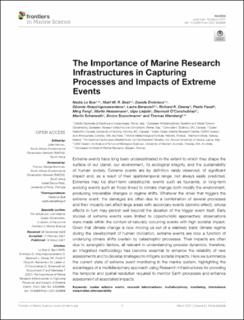| dc.description.abstract | Extreme events have long been underestimated in the extent to which they shape the surface of our planet, our environment, its ecological integrity, and the sustainability of human society. Extreme events are by definition rarely observed, of significant impact and, as a result of their spatiotemporal range, not always easily predicted. Extremes may be short-term catastrophic events such as tsunamis, or long-term evolving events such as those linked to climate change; both modify the environment, producing irreversible changes or regime shifts. Whatever the driver that triggers the extreme event, the damages are often due to a combination of several processes and their impacts can affect large areas with secondary events (domino effect), whose effects in turn may persist well beyond the duration of the trigger event itself. Early studies of extreme events were limited to opportunistic approaches: observations were made within the context of naturally occurring events with high societal impact. Given that climate change is now moving us out of a relatively static climate regime during the development of human civilization, extreme events are now a function of underlying climate shifts overlain by catastrophic processes. Their impacts are often due to synergistic factors, all relevant in understanding process dynamics; therefore, an integrated methodology has become essential to enhance the reliability of new assessments and to develop strategies to mitigate societal impacts. Here we summarize the current state of extreme event monitoring in the marine system, highlighting the advantages of a multidisciplinary approach using Research Infrastructures for providing the temporal and spatial resolution required to monitor Earth processes and enhance assessment of associated impacts. | en_US |
